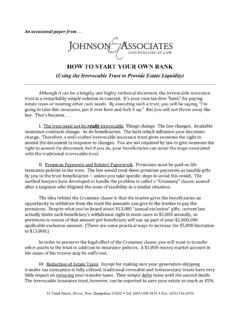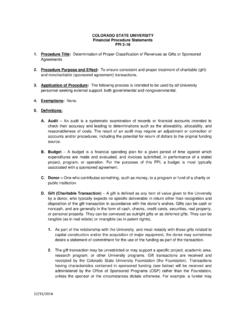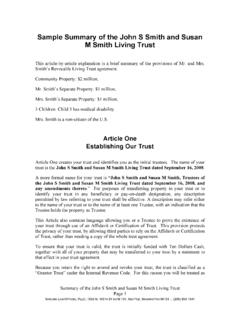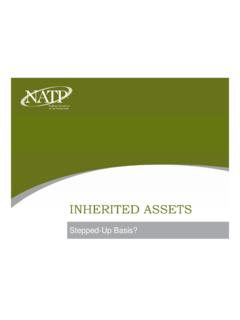Transcription of F. Trust Primer - Internal Revenue Service
1 F. Trust Primer by Elise Lin, Ron Shoemaker and Debra Kawecki Introduction The Trust instrument can be a pretty powerful piece of paper. The Trust form has always been considered as one of the foremost developments in the common law because of its flexibility. This flexibility allows the Trust instrument to serve a number of tax planning purposes. With a little planning, a Trust can create a current charitable tax deduction, avoid capital gains tax on the sale of appreciated assets, and significantly lower estate tax. For this reason, trusts are a common estate planning tool. The Code recognizes this and provides several provisions designed specifically for estate planning. The Code frequently permits trusts with charitable interests to achieve legitimate estate planning goals. However, planners with a variety of tax objectives have used trusts to generate tax-free savings in conjunction with compensation arrangements, pension planning, and education savings.
2 Because uses are not always appropriate, Congress and the Service have occasionally had to step in when tax planning borders on tax evasion. In many of these situations charitable objectives are decidedly subordinate to the desire to avoid capital gains tax or to control an asset into succeeding generations. Financial advisors function in a highly competitive market. Thus, it is not surprising that some plans may promise more tax savings than they should. To effectively deal with these abusive, often highly-promoted situations, the Service is expanding its abusive Trust program so that local units will be in place to coordinate the use of IRC 6700 penalties for abusive Trust promotions at the local level. The 1999 CPE, Topic M; discusses using the IRC 6700 tax shelter promotion penalty when promoters market plans that misuse the IRC 170 charitable contribution deduction. This article describes how IRC 4947 applies the Chapter 42 private foundation excise taxes to trusts that take advantage of charitable deductions.
3 IRC 4947 controls the application of the private foundation excise tax rules contained in Chapter 42 of the Code to both nonexempt charitable trusts and trusts with both charitable and noncharitable interests, entities that can be complex. This article starts with basic Trust concepts and then discusses charitable remainder trusts and charitable lead trusts. It also describes emerging IRC 4947 Trust issues. Trust Primer Part I - Basic Trust Principles 1. Overview In the simplest terms, a Trust is a three-party arrangement in which the founder of the Trust (commonly known as the donor, grantor, or settlor) transfers legal title of the Trust property (a res) to a trustee (a fiduciary with respect to the property) to hold and to manage for a third party (the Trust 's beneficiary) in accord with the grantor s intent. The beneficiary holds beneficial title to the property. A Trust can be created either during the grantor's lifetime or at his or her death by an instrument such as a will that takes effect at death.
4 Some essential Trust terms are: Grantor -The grantor is also known as the trustor, settlor, or founder. The grantor is the person who transfers the Trust property to the trustee. Trust Property -A Trust must have some assets, even if only one dollar. Trust property includes assets like cash, securities, real property, tangible personal property, and life insurance policies. The assets can be either transferred during life of the grantor ( inter vivos ) or at his or her death ( testamentary ). The Trust property is also referred to as the corpus, principal, estate or Trust res. Trustee -The trustee is the individual or entity responsible for holding and managing the Trust property for the benefit of the beneficiary. Trustees can be a corporate fiduciary or any competent individual who is not a minor. The trustee holds the legal title to the Trust property.
5 As such, the trustee has a fiduciary duty to the beneficiaries with respect to the Trust property. In the event of a breach of fiduciary duty, a trustee may be held personally liable. Such breaches include failing to pay out distributions or misappropriation. Beneficiary -The beneficiary is the individual or entity who will receive the benefits of the Trust property. The beneficiary holds the beneficial title to the Trust property. The Trust document must clearly identify the beneficiary or beneficiaries. 2. Purpose of the Trust Every Trust must have a legal purpose. The purpose is distinct from the grantor s motives or objectives in establishing a Trust . For example, a Trust can benefit a specific beneficiary and achieve tax benefits for the grantor. Benefiting the beneficiary is the 80 Trust Primer Trust s purpose. Achieving certain tax objectives might be the primary motive of the donor, but it is not the purpose of the Trust .
6 Trusts can provide advantages for estate, financial, personal or business purposes, including: 1. Giving a beneficiary the benefit of property, such as the income generated by property, with the property going to a successor beneficiary upon a contingency such as the initial beneficiary's death; 2. Enabling the grantor to delay payments of assets to beneficiaries until after they reach the age of majority. A Trust can provide partial distributions to a beneficiary and delay the ultimate distribution to the beneficiary to an age well beyond majority; 3. Protecting a beneficiary "from himself." These trusts, commonly called "spendthrift trusts", give the trustee the power to withhold payments to the beneficiary in case the beneficiary has legal judgments or claims against him or her. The beneficiary's creditors generally cannot reach assets in the Trust .
7 3. Tax Law Concepts A. Simple Trust A simple Trust must distribute all its income currently. Generally, it cannot accumulate income, distribute out of corpus, or pay money for charitable purposes. If a Trust distributes corpus during a year, as in the year it terminates, the Trust becomes a complex Trust for that year. Whether a Trust is simple or complex determines the amount of the personal exemption ($300 for simple trusts and $100 for complex trusts), that applies in calculating the tax owed. B. Complex Trust A complex Trust is any Trust that does not meet the requirements for a simple Trust . Complex trusts may accumulate income, distribute amounts other than current income and, make deductible payments for charitable purposes under section 642(c) of the Code. C. Grantor Trust A grantor Trust is a Trust over which the grantor has retained certain interests or control.
8 The grantor Trust rules in IRC 671-678 are anti-abuse rules. They prevent the grantor from taking tax advantages from assets that have not left his or her control. The 81 Trust Primer anti-abuse rules treat the grantor as owner of all or a portion of the Trust . The grantor is subject to tax on Trust income so treated even if he or she does not actually receive the income. D. Revocable Trust If the grantor retains the ability to revoke the Trust and revest the Trust assets in the grantor, the Trust is revocable and the income is taxable to the grantor under the grantor Trust rules. Assets in a revocable Trust are included in the grantor's gross estate for federal estate tax purposes. Revocable trusts also called living trusts, are one of the more frequently misunderstood Trust concepts. They are used primarily as a will substitute. Assets in Trust avoid the cost, time, expense, and publicity of probate.
9 Because a revocable Trust may be a will substitute, it may provide for direct gifts to charity as well as establishing a split interest Trust , a charitable remainder Trust , or a charitable lead Trust . For example, a revocable Trust may establish a charitable remainder Trust upon the grantor's death to benefit a surviving spouse or child. The noncharitable beneficiary can receive an income payment for life, or for a term of years. The remainder will pass to charity at the death of the noncharitable income recipient or the end of the term. Similarly, a grantor may use a will or a revocable Trust to establish a charitable lead Trust , with an interest for charity during a term of years or for the life of certain individuals, and the remainder to the grantor's spouse, child or other heir. E. Irrevocable Trust An irrevocable Trust is one that, by its terms, cannot be revoked. Part II - IRC 4947 The Tax Reform Act of 1969 imposed a new tax plan on charitable organizations and charitable giving.
10 Congress was responding to abuses, particularly from charities controlled by limited (typically family) interests. The most significant changes are the distinction between public charities and private foundations, and the excise taxes in Chapter 42 of the Code that apply to restrict the activities of private foundations. The provisions of Chapter 42 are anti-abuse rules designed to insure private foundations operate to achieve charitable purposes rather than benefit the limited interests that control them. 82 Trust Primer Private foundations are not the only narrowly controlled entities that enjoy tax advantages available for charitable giving. Trusts with only charitable beneficiaries and trusts with both charitable and noncharitable beneficiaries enjoy the benefit of tax deductible contributions. These trusts are also subject to the same abuses that led to the imposition of Chapter 42 on private foundations.















